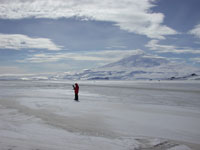|
|

|

|
Exploratorium
crew member Julie Konop on the sea ice.
|
|
|
(Click
for a larger image)
|
|
Lessons on Sea Ice
|

|
by
Mary K. Miller
December
7, 2001
This
place is called "The Ice" for good reason. Ice dominates
the landscape of much of Antarctica with a thick coat of brilliant
white. Solid pack ice also conceals what would be open sea
just out the window of my temporary office in McMurdo Station.
During winter and spring, the ice is thick enough that planes
can land on it, as we did when arriving from Christchurch
a few days ago.
Before
anyone here is allowed to venture off the solid ground of
the station and onto the sea ice on their own, they must attend
a full-day safety class conducted by the Field Safety Training
Program. (It’s also known as f-stop… we’re
quickly learning that every building and group at McMurdo
has two or more names, acronyms, or nicknames, contributing
to the confusion of any newcomer for at least the first week).
Our
instructor for the Sea Ice School is Ted Dettmar, chief story-teller
and station historian on the heroic age of Antarctica exploration
(he’s promised to give the Exploratorium crew a tour
of the hut used by the Scott expedition at Cape Evans later
this month, so stay tuned). Ted has been on the search-and-rescue
team in Antarctica for eight years and has seen plenty of
people get into trouble on the sea ice, something we definitely
want to avoid.
Before
leaving the station, we get a briefing on survival in Antarctica.
Weather can change quickly here, going from a clear, fine
day—called "condition three" to a blizzard,
or "condition one"—in a matter of hours. If
you’re out on the ice in condition one weather, the only
option is to hunker down and wait it out. Your chances of
making it through a Antarctic storm depend on the contents
of a survival bag that includes a tent, food, stove, a signal
mirror, and some extra cold-weather clothing. Because storms
can last two days here, the folks who put together the survival
bags also include some form of entertainment: a game, crosswords,
and a book. One popular title is "Survive," the
real-life account of a rugby team that crashed in the Andes
mountains and found an unconventional way to keep themselves
nourished while waiting for rescue (the story was encapsulated
in a bumper sticker I once saw: "Rugby players eat their
dead.").
Storms
are not the only risk when out and about on the sea ice. Weak
spots or pressure ridges can open up on the ice, leaving a
thin sheet--or nothing--between the water and a vehicle or
person. Ted tells us the story of a group from New Zealand’s
Scott Base who drove out on the ice in a heavy Hagglund track
vehicle. The $500,000 vehicle broke through a weak spot in
the ice and was submerged up to its emergency hatches in seawater.
Luckily, Hagglunds are designed to float, and nobody was hurt,
except perhaps for the bruised pride of the Kiwi driver (Kiwi
is the affectionate term for New Zealanders). The incident
makes for a sober lesson for anyone traveling on sea ice to
always gauge the thickness of the sea ice before driving over
it.
|

